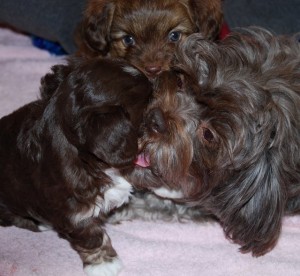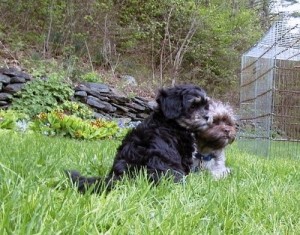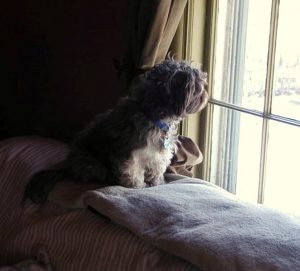 For eleven weeks more than a decade ago one of my dogs, Frica, daily reminded me of the disconnect between animal learning and teaching theory vs. the way we teach animals and expect them to learn. During this period, she imparted those lessons she considered critical to the survival of her puppies.
For eleven weeks more than a decade ago one of my dogs, Frica, daily reminded me of the disconnect between animal learning and teaching theory vs. the way we teach animals and expect them to learn. During this period, she imparted those lessons she considered critical to the survival of her puppies.
Among the many elements of this process I learned by watching Frica assume this role was the difference between how she taught her puppies and the way most companion dog folks teach theirs. The bulk of the scientific studies on the human approach describes how animals learn human-defined tasks using a process in an environment designed by humans based on human beliefs, needs, and perceptions. This is comparable to testing people’s knowledge of a subject that has no relevancy to them, using a test that is not user-friendly in an alien environment. An example of this might be asking a person with excellent verbal skills, but poor math ones, to solve 10 math problems in 10 minutes and labeling those unable to do this as learning disabled. Anyone who has experienced such “learning” horror shows would argue that this process does not represent sound understanding of how they learn and the best way to teach them!
Since I first addressed this subject, studies of of animal cognition, emotional contagion, and social learning as the primary mode of intra-animal learning have increased. Equally exciting, discoveries regarding the potential for human-domestic dog emotional contagion and social learning suggest that ultimately a more canine-friendly natural teaching system will prevail. But for now watching a dog or cat with good paternal skills teach their offspring may be the closest we get.
Compared to watching the way many people train young puppies today, watching Frica’s real-life teaching-learning interactions with her offspring was a different experience altogether. Some of the things she did took me a while to accept. And I freely admit that some days I struggled not to impose my will on the process. For example, unlike me, she felt no obligation to constantly fuss over her young from the beginning. The first week she tended to their needs, then jumped out of the pen that contained the maternity suite (i.e., a tastefully appointed crate) and joined me. This included when I read in bed before turning in for the night. I’d return her to the pen and she’d jump out again. I even went so far as to sleep on the floor in the room with the pups to teach her the “right” response. She still would sleep by me rather than with them. Being a slow human, it took me a while to grasp that she left them because they were fine. They were fed, clean, warm, sleepy, and content.
As time went on, I realized that leaving her puppies alone several times daily also was part of her teaching strategy. By the time the last puppy left a week after his brothers, all the puppies knew how to amuse and be comfortable by themselves. Only then did I realize that she had taught them to succeed in the human environments that give so many over-stimulated puppies problems: those in which the owners work or engage in other activities that necessitate the animal being left alone.
When physically and behaviorally attending to her puppies needs, Frica was a model of energy-efficiency. She spent most of her time the first month in the pen staying one step ahead of them, setting them up to succeed. She also taught each pup in accord with their specific needs instead of adopting some one-size-fits-all strategy. The biggest, most developmentally advanced puppy received lessons that taught him patience and gentleness. Simultaneously, she encouraged the other two to be more adventuresome and playful. By the time she finished, instead of the bigger pup beating up on the other two during play, the puppies constantly switched roles with the pinner becoming the pinned in games that left me exhausted just watching them.
In the next phase, Frica perched on the ottoman I’d placed next to the pen and observed their interactions from above. Sort of like an umpire or referee. As soon as anyone got out of line, she gave the miscreant The Look. If the misbehavior continued, she jumped into the pen and disciplined the troublemaker swiftly and unemotionally. If one of the puppies became distressed for some reason–they were forever going between the back of the crate and one side of the pen and then deciding they were stuck–she immediately jumped into the pen and offered problem-solving encouragement. Compare that to my human inclination which was to “rescue” them immediately.
As the puppies grew, Frica moved off the ottoman and onto the floor outside the pen. From there she observed them while they played and explored their increasingly complex world, thanks to the objects and toys I routinely added to their world. Over time, she increased how long she gave them to figure things out for themselves–whether that be a tiff with a sibling or getting a toy beyond their reach–before she intervened.
Every evening while I ate my dinner or did chores before going to bed and every morning while I did yoga, Frica would join them in the pen in my second floor office. At first, she nursed them. However, as time went on and they preferred solid food, the silence of these intervals intrigued me. When I crept up the stairs and peeped into the office, I saw her and her puppies lined up like furry sphinxes beside each other. I knew they were communicating, but I had no idea what. Once again I realized how paltry human sensory perception and communication were when compared to that of animals’.
Frica’s teaching methods were always so subtle and energy-efficient I often didn’t realize she was in teaching mode. Or rather, it finally dawned on me that, unlike us humans and the teaching and learning methods we impose on animals, she always was in her teaching mode and her puppies were always learning. It wasn’t a process for any of them. It was a way of life.
One final image I want to share because it sticks so clearly in my mind. I kept the last puppy until he was eleven weeks old. Although he  soon learned to relieve himself outdoors like his mother did, he became distracted by my presence if I was out there too. Consequently, I’d put him in an exercise pen and go inside and observe him through the window. Within a matter of minutes, he’d do his thing, I’d spring him, and he and Frica and I would play or just hang out together as she continued his education.
soon learned to relieve himself outdoors like his mother did, he became distracted by my presence if I was out there too. Consequently, I’d put him in an exercise pen and go inside and observe him through the window. Within a matter of minutes, he’d do his thing, I’d spring him, and he and Frica and I would play or just hang out together as she continued his education.
One gray and rainy day, I put him in the pen as usual. Only this time he decided he wanted out immediately and began making a fuss as soon as I came indoors. Then the most amazing thing happened. Frica walked to within 3 feet of the pen and stood there like a statue looking at him. At first, he barked and whined at her. Then he dug at the grass at the base of the pen. Still she stood there staring at him without moving a muscle. Soon it began to rain harder and he made more of a fuss. Inside, I felt torn. Frica looked like a frozen, dripping hairball and the puppy like an animated wet one. Still, her utter stillness intrigued me. What was going on between the two of them?
I’ll never know. However, I do know the result. The puppy suddenly settled, peed and pooped in record time, and his mom went over to him wagging her tail. Everything about her communicated, “Well done!”
 The evening and morning after the last puppy left, Frica ran up the stairs to the office where the now-cleaned and -collapsed pen remained. I heard her whining and scratching at the newly laundered fleece mat that had been in the pen but which I’d put back in a dog bed in the corner. Then she raced downstairs again and jumped into my lap and studied me intently.
The evening and morning after the last puppy left, Frica ran up the stairs to the office where the now-cleaned and -collapsed pen remained. I heard her whining and scratching at the newly laundered fleece mat that had been in the pen but which I’d put back in a dog bed in the corner. Then she raced downstairs again and jumped into my lap and studied me intently.
Maybe I made it up, but I swear she communicated, Where’s my puppy?
“They’re all gone,” I answered, and got all weepy.
Then given good dog we was, she licked me: Oh. They’ll be fine. And so will we.
Among the many elements of this process I learned by watching Frica assume this role was the difference between how she taught her puppies and the way most companion dog folks teach theirs. The bulk of the scientific studies on the human approach describes how animals learn human-defined tasks using a process in an environment designed by humans based on human beliefs, needs, and perceptions. This is comparable to testing people’s knowledge of a subject that has no relevancy to them, using a test that is not user-friendly in an alien environment. An example of this might be asking a person with excellent verbal skills, but poor math ones, to solve 10 math problems in 10 minutes and labeling those unable to do this as learning disabled. Anyone who has experienced such “learning” horror shows would argue that this process does not represent sound understanding of how they learn and the best way to teach them!
Since I first addressed this subject, studies of of animal cognition, emotional contagion, and social learning as the primary mode of intra-animal learning have increased. Equally exciting, discoveries regarding the potential for human-domestic dog emotional contagion and social learning suggest that ultimately a more canine-friendly natural teaching system will prevail. But for now watching a dog or cat with good paternal skills teach their offspring may be the closest we get.
Compared to watching the way many people train young puppies today, watching Frica’s real-life teaching-learning interactions with her offspring was a different experience altogether. Some of the things she did took me a while to accept. And I freely admit that some days I struggled not to impose my will on the process. For example, unlike me, she felt no obligation to constantly fuss over her young from the beginning. The first week she tended to their needs, then jumped out of the pen that contained the maternity suite (i.e., a tastefully appointed crate) and joined me. This included when I read in bed before turning in for the night. I’d return her to the pen and she’d jump out again. I even went so far as to sleep on the floor in the room with the pups to teach her the “right” response. She still would sleep by me rather than with them. Being a slow human, it took me a while to grasp that she left them because they were fine. They were fed, clean, warm, sleepy, and content.
As time went on, I realized that leaving her puppies alone several times daily also was part of her teaching strategy. By the time the last puppy left a week after his brothers, all the puppies knew how to amuse and be comfortable by themselves. Only then did I realize that she had taught them to succeed in the human environments that give so many over-stimulated puppies problems: those in which the owners work or engage in other activities that necessitate the animal being left alone.
When physically and behaviorally attending to her puppies needs, Frica was a model of energy-efficiency. She spent most of her time the first month in the pen staying one step ahead of them, setting them up to succeed. She also taught each pup in accord with their specific needs instead of adopting some one-size-fits-all strategy. The biggest, most developmentally advanced puppy received lessons that taught him patience and gentleness. Simultaneously, she encouraged the other two to be more adventuresome and playful. By the time she finished, instead of the bigger pup beating up on the other two during play, the puppies constantly switched roles with the pinner becoming the pinned in games that left me exhausted just watching them.
In the next phase, Frica perched on the ottoman I’d placed next to the pen and observed their interactions from above. Sort of like an umpire or referee. As soon as anyone got out of line, she gave the miscreant The Look. If the misbehavior continued, she jumped into the pen and disciplined the troublemaker swiftly and unemotionally. If one of the puppies became distressed for some reason–they were forever going between the back of the crate and one side of the pen and then deciding they were stuck–she immediately jumped into the pen and offered problem-solving encouragement. Compare that to my human inclination which was to “rescue” them immediately.
As the puppies grew, Frica moved off the ottoman and onto the floor outside the pen. From there she observed them while they played and explored their increasingly complex world, thanks to the objects and toys I routinely added to their world. Over time, she increased how long she gave them to figure things out for themselves–whether that be a tiff with a sibling or getting a toy beyond their reach–before she intervened.
Every evening while I ate my dinner or did chores before going to bed and every morning while I did yoga, Frica would join them in the pen in my second floor office. At first, she nursed them. However, as time went on and they preferred solid food, the silence of these intervals intrigued me. When I crept up the stairs and peeped into the office, I saw her and her puppies lined up like furry sphinxes beside each other. I knew they were communicating, but I had no idea what. Once again I realized how paltry human sensory perception and communication were when compared to that of animals’.
Frica’s teaching methods were always so subtle and energy-efficient I often didn’t realize she was in teaching mode. Or rather, it finally dawned on me that, unlike us humans and the teaching and learning methods we impose on animals, she always was in her teaching mode and her puppies were always learning. It wasn’t a process for any of them. It was a way of life.
One final image I want to share because it sticks so clearly in my mind. I kept the last puppy until he was eleven weeks old. Although he soon learned to relieve himself outdoors like his mother did, he became distracted by my presence if I was out there too. Consequently, I’d put him in an exercise pen and go inside and observe him through the window. Within a matter of minutes, he’d do his thing, I’d spring him, and he and Frica and I would play or just hang out together as she continued his education.
soon learned to relieve himself outdoors like his mother did, he became distracted by my presence if I was out there too. Consequently, I’d put him in an exercise pen and go inside and observe him through the window. Within a matter of minutes, he’d do his thing, I’d spring him, and he and Frica and I would play or just hang out together as she continued his education.
One gray and rainy day, I put him in the pen as usual. Only this time he decided he wanted out immediately and began making a fuss as soon as I came indoors. Then the most amazing thing happened. Frica walked to within 3 feet of the pen and stood there like a statue looking at him. At first, he barked and whined at her. Then he dug at the grass at the base of the pen. Still she stood there staring at him without moving a muscle. Soon it began to rain harder and he made more of a fuss. Inside, I felt torn. Frica looked like a frozen, dripping hairball and the puppy like an animated wet one. Still, her utter stillness intrigued me. What was going on between the two of them?
I’ll never know. However, I do know the result. The puppy suddenly settled, peed and pooped in record time, and his mom went over to him wagging her tail. Everything about her communicated, “Well done!”
Maybe I made it up, but I swear she communicated, Where’s my puppy?
“They’re all gone,” I answered, and got all weepy.
Then given good dog we was, she licked me: Oh. They’ll be fine. And so will we.